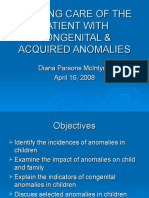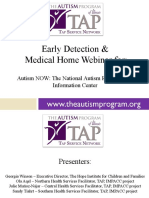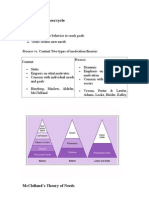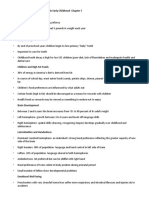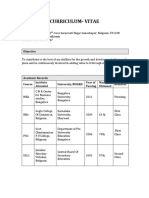Autism Alarm
Autism Alarm
Uploaded by
Umair KaziCopyright:
Available Formats
Autism Alarm
Autism Alarm
Uploaded by
Umair KaziCopyright
Available Formats
Share this document
Did you find this document useful?
Is this content inappropriate?
Copyright:
Available Formats
Autism Alarm
Autism Alarm
Uploaded by
Umair KaziCopyright:
Available Formats
A U T I S M A.L.A.R.M.
Autism is prevalent Listen to parents
1 out of 6 children are diagnosed with a developmental disorder and/or behavioral problem Approximately 1 in 150 children are diagnosed with an autism spectrum disorder Developmental disorders have subtle signs and may be easily missed Early signs of autism are often present before 18 months Parents usually DO have concerns that something is wrong Parents generally DO give accurate and quality information When parents do not spontaneously raise concerns, ask if they have any
Act early
Make screening and surveillance an important part of your practice (as endorsed by the AAP) Know the subtle differences between typical and atypical development Learn to recognize red flags Use validated screening tools and identify problems early Improve the quality of life for children and their families through early and appropriate intervention
Refer
To Early Intervention or a local school program (do not wait for a diagnosis) To an autism specialist, or team of specialists, immediately for a definitive diagnosis To audiology and rule out a hearing impairment To local community resources for help and family support
Monitor
Schedule a follow-up appointment to discuss concerns more thoroughly Look for other conditions known to be associated with autism (eg, seizures, GI, sleep, behavior) Educate parents and provide them with up-to-date information Advocate for families with local early intervention programs, schools, respite care agencies, and insurance companies Continue surveillance and watch for additional or late signs of autism and/or other developmental disorders Continue to provide a medical home For More Information: www.medicalhomeinfo.org
The recommendations in this document do not indicate an exclusive course of treatment or serve as a standard of medical care. Variations, taking into account individual circumstances, may be appropriate. August 2007
This project is funded by a cooperative agreement between the American Academy of Pediatrics and the National Center on Birth Defects and Developmental Disabilities at the Centers for Disease Control and Prevention.
S URVEILLANCE AND S CREENING A LGORITHM: A UTISM S PECTRUM D ISORDERS ( A S D S)
1a: Pediatric Patient at Preventive Care Visit
2: Perform Surveillance Score 1 for Each Risk Factor: Sibling with ASD Parental Concern Other Caregiver Concern Pediatrician Concern Start
Legend
1b: Extra Visit for Autism-Related Concern, ASD Risk Factor, or Other Developmental/ Behavioral Concern
Action/Process Decision
Score = 2+
3: What is the Score? Score = 1 3a: Is the Patient at Least 18-Months Old?
Score = 0
4: Is this an 18- or 24-Month Visit?
Yes
No
No
Yes 5c: Administer ASDSpecific Screening Tool
5a: Evaluate SocialCommunication Skills
5b: Administer ASDSpecific Screening Tool
6a: Are the Results Positive or Concerning? No 7a: 1. Provide Parental Education 2. Schedule Extra Visit Within 1 Month 3. Re-enter Algorithm at 1b Yes Yes
6b: Are the Results Positive or Concerning? No 7b: 1. Schedule Next Preventive Visit 2. Re-enter Algorithm at 1a
8: 1. Provide Parental Education 2. Simultaneously Refer for: a. Comprehensive ASD Evaluation b. Early Intervention/Early Childhood Education Services c. Audiologic Evaluation 3. Schedule Follow-Up Visit 4. Re-enter Algorithm at 1b
Reprinted from Pediatrics, November 2007. Identification and Evaluation of Children With Autism Spectrum Disorders. www.pediatrics.org Copyright 2007 by the American Academy of Pediatrics.
You might also like
- Family-Based Treatment For Young Children With OCD WorkbookDocument113 pagesFamily-Based Treatment For Young Children With OCD WorkbookJu da SilvaNo ratings yet
- Illinois Health Care Provider FINALDocument17 pagesIllinois Health Care Provider FINALLegal CouncilNo ratings yet
- Benefits of Early Detection and IdentificationDocument46 pagesBenefits of Early Detection and IdentificationManisha Verma100% (1)
- Guide To Genetic CounselingDocument24 pagesGuide To Genetic Counselingmady_elenutza0% (1)
- W3-4 Functions of CommunicationDocument19 pagesW3-4 Functions of CommunicationJrick Escobar50% (2)
- Autism Guideline For PatientsDocument2 pagesAutism Guideline For PatientsNastitiPutriArianiNo ratings yet
- HCP PPT Presentation Final Cleared Updated 1.19.24Document44 pagesHCP PPT Presentation Final Cleared Updated 1.19.24carla caroline AraujoNo ratings yet
- EBCR AfiahDocument25 pagesEBCR AfiahAfiah SalsabilaNo ratings yet
- HCP PPT Presentation Final Cleared Updated 1.19.24 1Document44 pagesHCP PPT Presentation Final Cleared Updated 1.19.24 1carla caroline AraujoNo ratings yet
- A Parent's Handbook:: Your Guide To Autism ProgramsDocument36 pagesA Parent's Handbook:: Your Guide To Autism ProgramsPerez FabiolaNo ratings yet
- New Parent PacketDocument11 pagesNew Parent PacketchicocecconNo ratings yet
- Health and Wellness: DR Kainat Faizan BSPT (G Old-Medalist), PPDPTDocument32 pagesHealth and Wellness: DR Kainat Faizan BSPT (G Old-Medalist), PPDPTAflaha KhanNo ratings yet
- Autism Spectrum DisordersDocument46 pagesAutism Spectrum DisordersnchoucaireNo ratings yet
- Opt Nextsteps06Document8 pagesOpt Nextsteps06api-297150429No ratings yet
- Research Paper 2Document6 pagesResearch Paper 2Anonymous 6WSfYwNo ratings yet
- Post-Diagnostic Management and Follow-Up Care For Autism Spectrum Disorder - Canadian Paediatric SocietyDocument14 pagesPost-Diagnostic Management and Follow-Up Care For Autism Spectrum Disorder - Canadian Paediatric Societyguillermo.calderaro.pediatraNo ratings yet
- Psychiatric Assessment of Child and Adolescent PatientsDocument48 pagesPsychiatric Assessment of Child and Adolescent PatientsSamuel AladejareNo ratings yet
- Disclosure Pada Anak Dengan HIVDocument26 pagesDisclosure Pada Anak Dengan HIVjust amoeba, spNo ratings yet
- Autism Handbook WebDocument48 pagesAutism Handbook Webgelatta100% (1)
- 1b Paediatric NursingDocument19 pages1b Paediatric NursingBOBNo ratings yet
- Who Can Diagnose Autism Spectrum Disorders?Document8 pagesWho Can Diagnose Autism Spectrum Disorders?DanielNo ratings yet
- Assessment of ASDs - Psychopharm Update PDFDocument55 pagesAssessment of ASDs - Psychopharm Update PDFMihai PredescuNo ratings yet
- Genetic CounselingDocument26 pagesGenetic CounselingJEEJANo ratings yet
- History Taking and Physical Examination, Level 5Document48 pagesHistory Taking and Physical Examination, Level 5CLEMENT100% (1)
- Early Identification and Screening: Definition of Developmental DelayDocument7 pagesEarly Identification and Screening: Definition of Developmental Delayadheena simonNo ratings yet
- autismHandbookYAB PDFDocument79 pagesautismHandbookYAB PDFRaí Caetano de JesusNo ratings yet
- 2015 MHQP Pediatric Routine Preventive Care GuidelinesDocument12 pages2015 MHQP Pediatric Routine Preventive Care GuidelinesVladimir BasurtoNo ratings yet
- Newborn ScreeningDocument18 pagesNewborn ScreeningKayNo ratings yet
- What Is Autism?: Characteristics of Children With AutismDocument7 pagesWhat Is Autism?: Characteristics of Children With AutismAnandNarayananNo ratings yet
- D.2 Odd 2018Document24 pagesD.2 Odd 2018Kibru le EyesusNo ratings yet
- Child & Adolesent 5th YearDocument93 pagesChild & Adolesent 5th YearRaghadNo ratings yet
- What Is Regressive Autism?Document9 pagesWhat Is Regressive Autism?Autism ParentingNo ratings yet
- Autism Facts Vs Autism MythsDocument14 pagesAutism Facts Vs Autism Mythsawardeco01No ratings yet
- Brochure Example 1Document2 pagesBrochure Example 1Azeem FiqriNo ratings yet
- Care of The Patient With Congenital Anomalies 3Document60 pagesCare of The Patient With Congenital Anomalies 3ladydianamacNo ratings yet
- DR Eve McAllister Psychological Interventions For TicsDocument79 pagesDR Eve McAllister Psychological Interventions For Ticsmatej zdNo ratings yet
- Parent's Guide To AutismDocument12 pagesParent's Guide To AutismJuma BlakeNo ratings yet
- Family Centred Care For Children With Down SyndromeDocument56 pagesFamily Centred Care For Children With Down SyndromeMarwa RashadNo ratings yet
- Early Intervention Is Common SenseDocument33 pagesEarly Intervention Is Common SenseNadia Aisyah AzminNo ratings yet
- Integrated Management On Childhood Imci ReportDocument29 pagesIntegrated Management On Childhood Imci ReportvernaNo ratings yet
- Introduction To Newborn ScreeningDocument28 pagesIntroduction To Newborn ScreeningfuufNo ratings yet
- When Should The Disclosure Process Begin?Document13 pagesWhen Should The Disclosure Process Begin?Victor BayNo ratings yet
- Asd 2Document2 pagesAsd 2www.rulermyanmar777No ratings yet
- CPC 3Document47 pagesCPC 3Kenneth NuñezNo ratings yet
- Parenting - AsdDocument9 pagesParenting - Asdapi-391945267No ratings yet
- Adhd - Winter 11thDocument17 pagesAdhd - Winter 11thlatu spamzNo ratings yet
- Genetic CounsellingDocument23 pagesGenetic Counsellingdiv100% (3)
- Apresentação de Desenvolvimento InfamtilDocument25 pagesApresentação de Desenvolvimento InfamtilCiclos Desenvolvimento InfantojuvenilNo ratings yet
- Adhd ChimDocument56 pagesAdhd ChimjeavilaNo ratings yet
- The Autism Program of Illinois Webinar With Autism NOW April 26, 2011Document28 pagesThe Autism Program of Illinois Webinar With Autism NOW April 26, 2011The Autism NOW CenterNo ratings yet
- What Is AutismDocument40 pagesWhat Is AutismMerr AbeNo ratings yet
- Non Accidental Injury in ChildrenDocument2 pagesNon Accidental Injury in ChildrenDoxo RubicinNo ratings yet
- Chapter 9 Health SupervisionDocument9 pagesChapter 9 Health SupervisionKatrina UrbanoNo ratings yet
- Book 14Document2 pagesBook 14Vikram Raj SinghNo ratings yet
- Training - Age Specific CompetencyDocument14 pagesTraining - Age Specific CompetencyKrishna Hospital & Research Centre HaldwaniNo ratings yet
- ADHD: Attention Deficit Hyperactivity Disorder: The 21 st century illness?From EverandADHD: Attention Deficit Hyperactivity Disorder: The 21 st century illness?No ratings yet
- Newborn Screening JournalDocument1 pageNewborn Screening JournalRommel Marcos Jr.No ratings yet
- A Parent's Handbook:: Your Guide To Autism ProgramsDocument40 pagesA Parent's Handbook:: Your Guide To Autism ProgramsJanice AmlonNo ratings yet
- Preventive Pediatric Health Care 2Document125 pagesPreventive Pediatric Health Care 2thorfinthors44No ratings yet
- Child-Dev-Milestones PPT For-Parents FINAL CLEARED-11.14.23Document25 pagesChild-Dev-Milestones PPT For-Parents FINAL CLEARED-11.14.23Ciclos Desenvolvimento InfantojuvenilNo ratings yet
- Assessment, Diagnosis and Treatment: BY Ms Maryam Noor Lecturer Department of PsychologyDocument16 pagesAssessment, Diagnosis and Treatment: BY Ms Maryam Noor Lecturer Department of PsychologyhaadiaNo ratings yet
- CBS Collborative Teacher InquiryDocument8 pagesCBS Collborative Teacher InquiryCitlalli Martinez GarciaNo ratings yet
- DLL - English 2 - Q2 - W5Document5 pagesDLL - English 2 - Q2 - W5gabrielle mamaliasNo ratings yet
- Character Description English Presentation Colorful Organic Children IllustrationsDocument9 pagesCharacter Description English Presentation Colorful Organic Children IllustrationsCENTO RIZALYN FAJARDONo ratings yet
- Comparative Analysis of Classification Algorithms On Diferrent Dataset Using Weka SW PDFDocument5 pagesComparative Analysis of Classification Algorithms On Diferrent Dataset Using Weka SW PDFhayder HNo ratings yet
- Benda Hidup Dan Benda Bukan HidupDocument11 pagesBenda Hidup Dan Benda Bukan HidupVanessa SchultzNo ratings yet
- Progress Report - NurseryDocument2 pagesProgress Report - Nurseryoffice.wilbethmcaNo ratings yet
- Motivation ProcessDocument7 pagesMotivation ProcessAmit729No ratings yet
- Introduction To Social Psychology NotesDocument5 pagesIntroduction To Social Psychology Notesarunima2001No ratings yet
- Cda and IdeologyDocument24 pagesCda and Ideologyhela_makhloufNo ratings yet
- Wbly DigitalDocument3 pagesWbly Digitalapi-360976690No ratings yet
- Module 1. Developing EntrepreneurshipDocument15 pagesModule 1. Developing EntrepreneurshipKabir ShariffNo ratings yet
- Lessons 04A-04DDocument8 pagesLessons 04A-04DLyanettNo ratings yet
- Monitoring, Evaluation, Accountability & Learning (Meal) AssistantDocument5 pagesMonitoring, Evaluation, Accountability & Learning (Meal) AssistantMohamedi MirajiNo ratings yet
- Nouf Fahad Binjubair: HR Business PartnerDocument4 pagesNouf Fahad Binjubair: HR Business PartnerMohannad MoheisenNo ratings yet
- The USe of Process Approach in WritingDocument9 pagesThe USe of Process Approach in WritingHedhedia Cajepe100% (1)
- Physical and Cognitive Development in Early ChildhoodDocument6 pagesPhysical and Cognitive Development in Early ChildhoodKessianne Fabien-DawsonNo ratings yet
- Designing For The Human SensesDocument50 pagesDesigning For The Human SensesRahaf MachaalNo ratings yet
- Introduction To ML P2Document30 pagesIntroduction To ML P2tester123_mailNo ratings yet
- Qualitative Characteristics of Accounting InformationDocument8 pagesQualitative Characteristics of Accounting InformationDiah Ayu KusumawardaniNo ratings yet
- Rubric - Skill Test - Special Test 2020Document1 pageRubric - Skill Test - Special Test 2020Nik Ahmad AlimNo ratings yet
- PurpossiveDocument11 pagesPurpossiveHamza Dawid HamidNo ratings yet
- Check EssayDocument3 pagesCheck Essayjim.nguyen302No ratings yet
- A Synchronic Study of Semantics in Selected Akan Choral Compositions in GhanaDocument8 pagesA Synchronic Study of Semantics in Selected Akan Choral Compositions in GhanaDennis UdokaNo ratings yet
- Jessica M. Wood: Social Studies AND German Teacher ProfileDocument3 pagesJessica M. Wood: Social Studies AND German Teacher Profilejmwood82No ratings yet
- Objective 2Document3 pagesObjective 2EduardoAlejoZamoraJr.No ratings yet
- Introduction To Organizational CommunicationDocument18 pagesIntroduction To Organizational CommunicationJULIA ALLANANo ratings yet
- Curriculum-Vitae: Vinay V RamaneDocument3 pagesCurriculum-Vitae: Vinay V RamaneVinay RamaneNo ratings yet
- Quiz 3 90 - 100Document10 pagesQuiz 3 90 - 100Deuter AbusoNo ratings yet
- Child Abuse Lesson PlanDocument7 pagesChild Abuse Lesson PlanIrvie manalacNo ratings yet


































